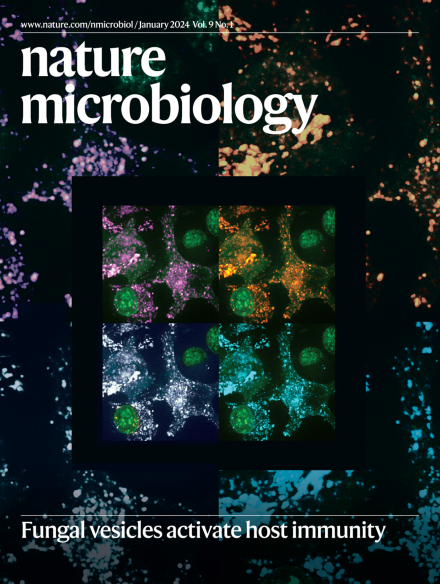IFIT2-IFIT3抗病毒复合物靶向病毒mrna上的短5'非翻译区以抑制翻译。
IF 19.4
1区 生物学
Q1 MICROBIOLOGY
引用次数: 0
摘要
识别外源RNA对病毒的先天免疫反应至关重要。干扰素(IFN)诱导的四肽重复(IFIT) 2和3蛋白在病毒感染后高度上调,但缺乏对其抗病毒作用的机制了解。在这里,我们证明了短的5'非翻译区(UTRs),许多病毒mrna的特征,可以通过IFIT2和IFIT3作为先天免疫识别的分子模式。利用冷冻电镜(cryo-EM)对3.2 Å的IFIT2-IFIT3复合物进行结构测定,揭示了一个交换结构域的异二聚体,该异二聚体是识别病毒mRNA 5'端、翻译抑制和抗病毒活性所必需的。至关重要的是,病毒或宿主的5' UTR长度小于50个核苷酸是IFIT2-IFIT3复合物抑制翻译的必要条件和充分条件。因此,多种mrna含有短5' utr的病毒,如水疱性口炎病毒和副流感病毒3,对ifit2 - ifit3介导的抗病毒活性敏感。因此,我们的工作揭示了一种利用病毒基因组大小固有限制的抗病毒核酸免疫识别模式。本文章由计算机程序翻译,如有差异,请以英文原文为准。
The IFIT2-IFIT3 antiviral complex targets short 5' untranslated regions on viral mRNAs for translation inhibition.
Recognition of foreign RNA is critical for the innate immune response to viruses. Interferon (IFN)-induced proteins with tetratricopeptide repeats (IFIT) 2 and 3 are highly upregulated following viral infection, but mechanistic insight into their antiviral role is lacking. Here we demonstrate that short 5' untranslated regions (UTRs), a characteristic of many viral mRNAs, can serve as a molecular pattern for innate immune recognition via IFIT2 and IFIT3. Structure determination of the IFIT2-IFIT3 complex at 3.2 Å using cryo-EM reveals a domain-swapped heterodimer that is required for recognition of the viral mRNA 5' end, translation inhibition and antiviral activity. Critically, viral or host 5' UTR lengths less than 50 nucleotides are necessary and sufficient to enable translation inhibition by the IFIT2-IFIT3 complex. Accordingly, diverse viruses whose mRNAs contain short 5' UTRs, such as vesicular stomatitis virus and parainfluenza virus 3, are sensitive to IFIT2-IFIT3-mediated antiviral activity. Our work thus reveals a pattern of antiviral nucleic acid immune recognition that takes advantage of the inherent constraints on viral genome size.
求助全文
通过发布文献求助,成功后即可免费获取论文全文。
去求助
来源期刊

Nature Microbiology
Immunology and Microbiology-Microbiology
CiteScore
44.40
自引率
1.10%
发文量
226
期刊介绍:
Nature Microbiology aims to cover a comprehensive range of topics related to microorganisms. This includes:
Evolution: The journal is interested in exploring the evolutionary aspects of microorganisms. This may include research on their genetic diversity, adaptation, and speciation over time.
Physiology and cell biology: Nature Microbiology seeks to understand the functions and characteristics of microorganisms at the cellular and physiological levels. This may involve studying their metabolism, growth patterns, and cellular processes.
Interactions: The journal focuses on the interactions microorganisms have with each other, as well as their interactions with hosts or the environment. This encompasses investigations into microbial communities, symbiotic relationships, and microbial responses to different environments.
Societal significance: Nature Microbiology recognizes the societal impact of microorganisms and welcomes studies that explore their practical applications. This may include research on microbial diseases, biotechnology, or environmental remediation.
In summary, Nature Microbiology is interested in research related to the evolution, physiology and cell biology of microorganisms, their interactions, and their societal relevance.
 求助内容:
求助内容: 应助结果提醒方式:
应助结果提醒方式:


